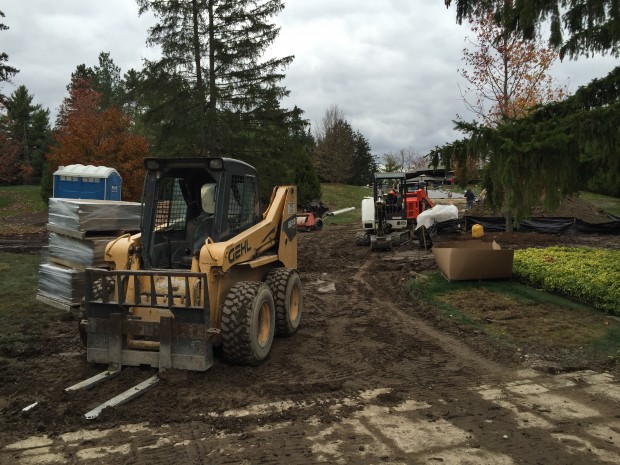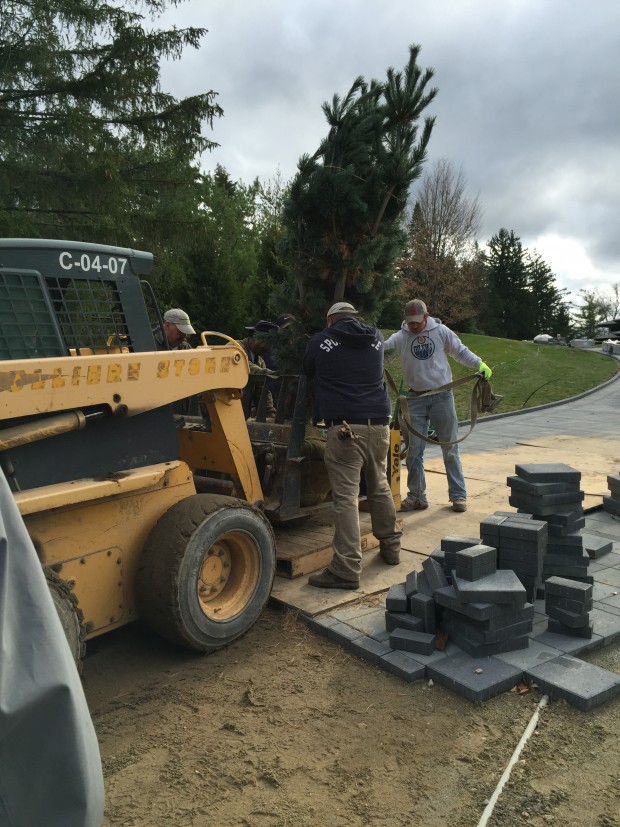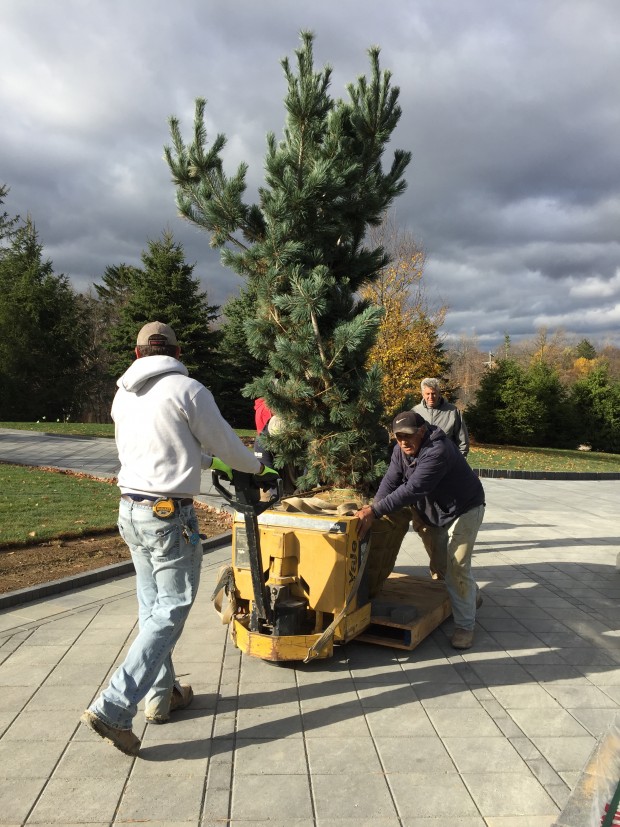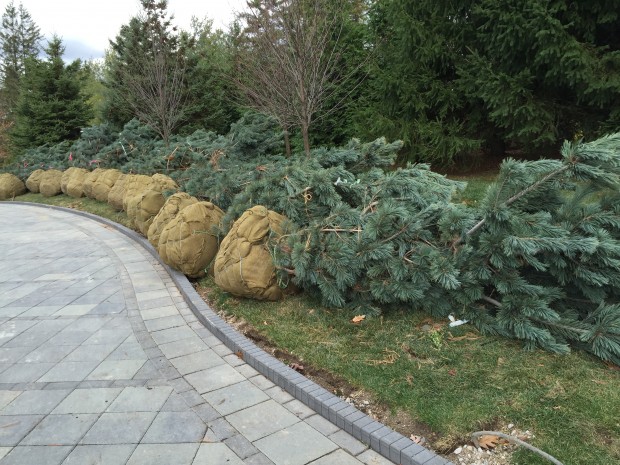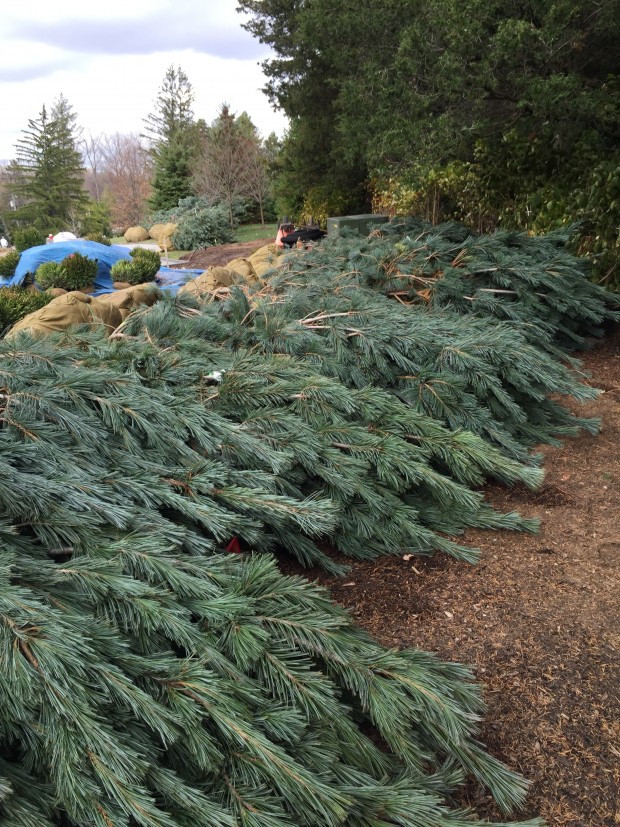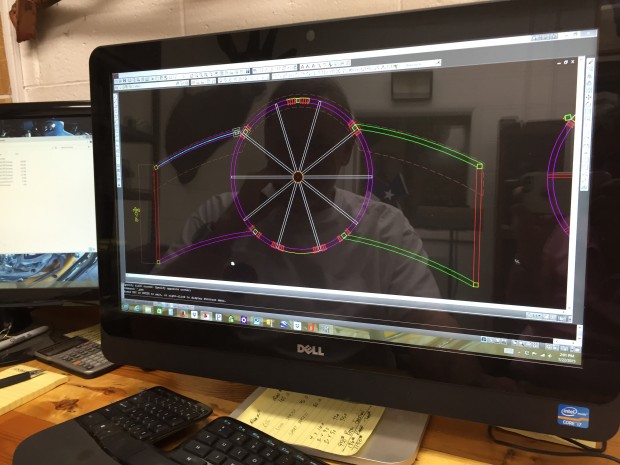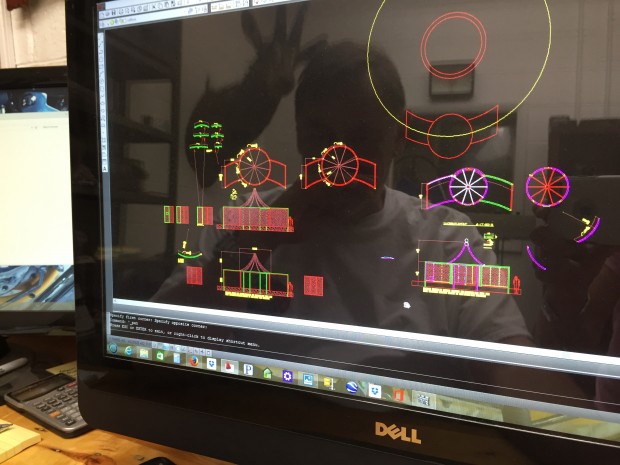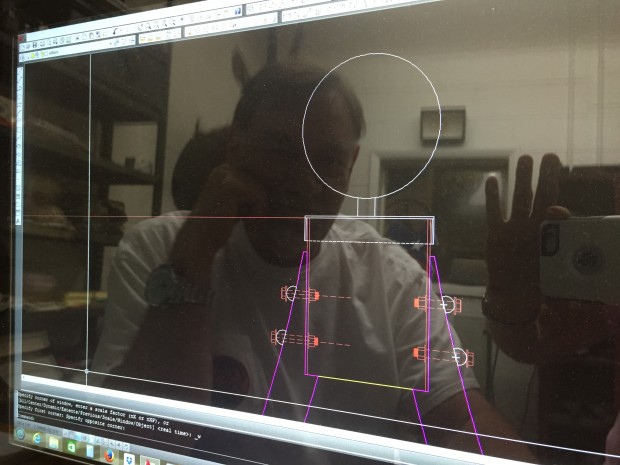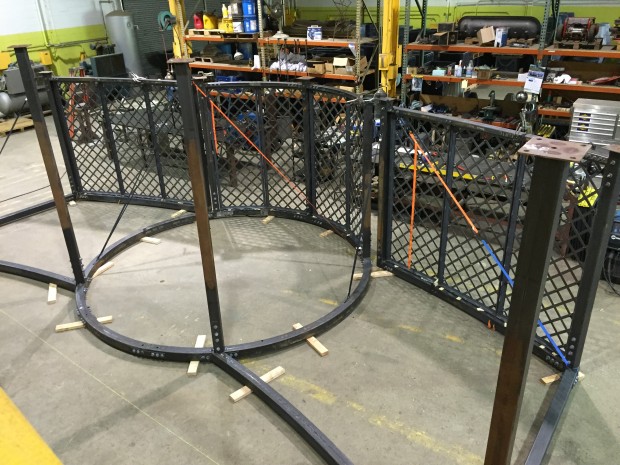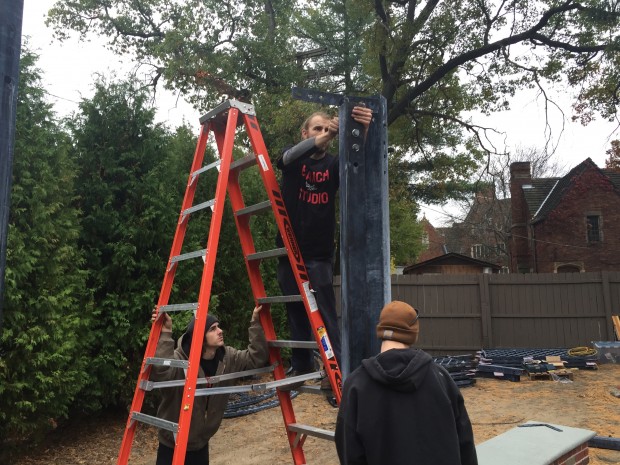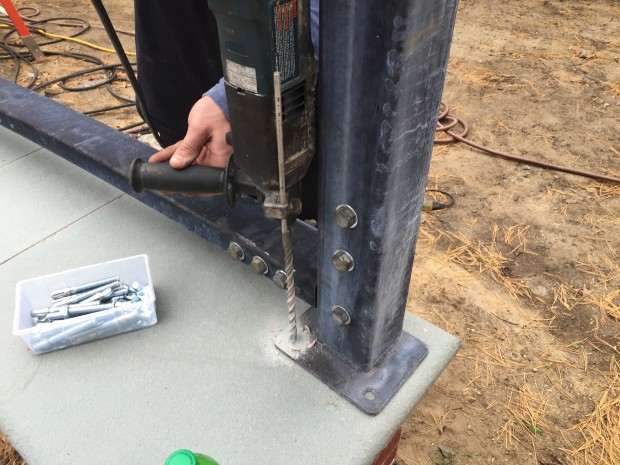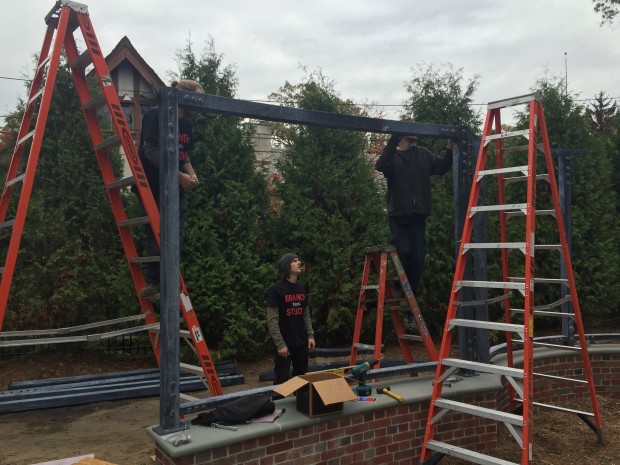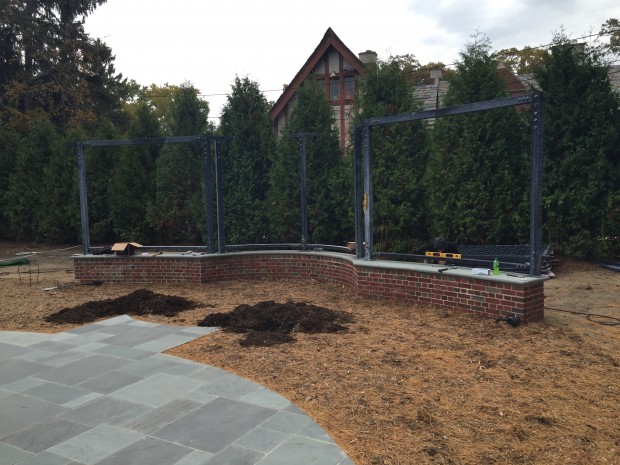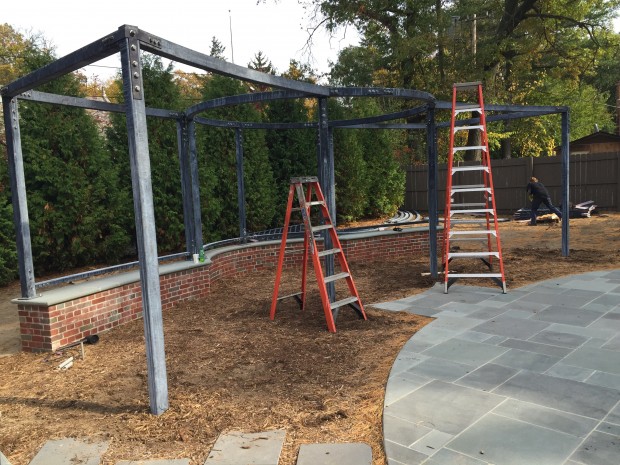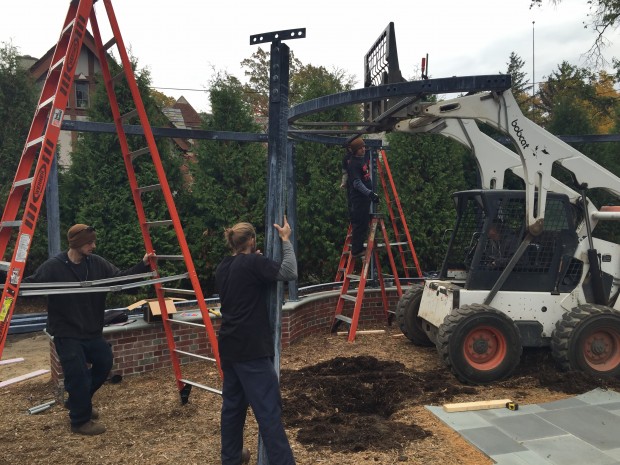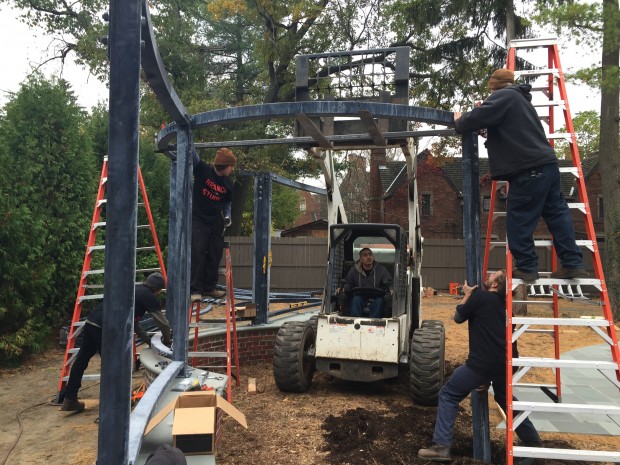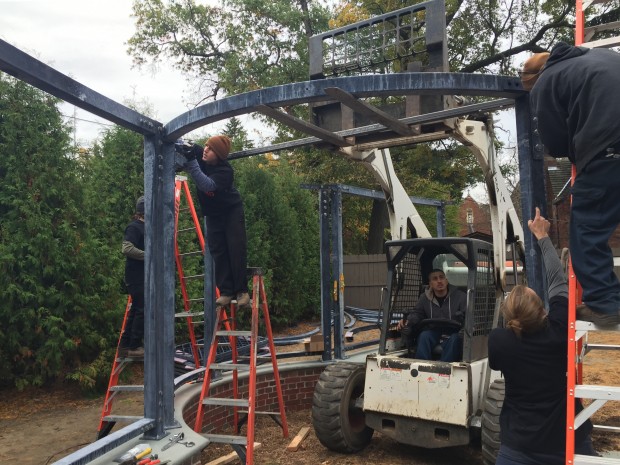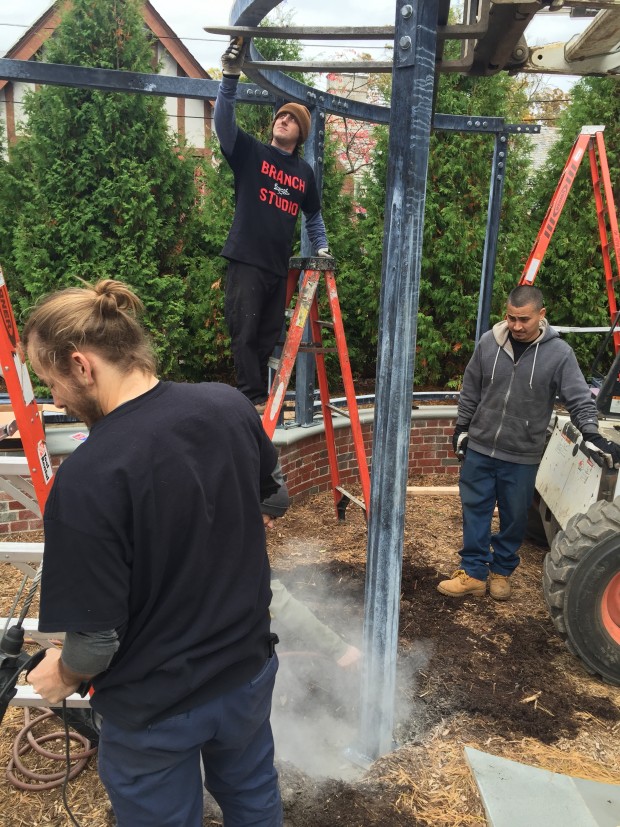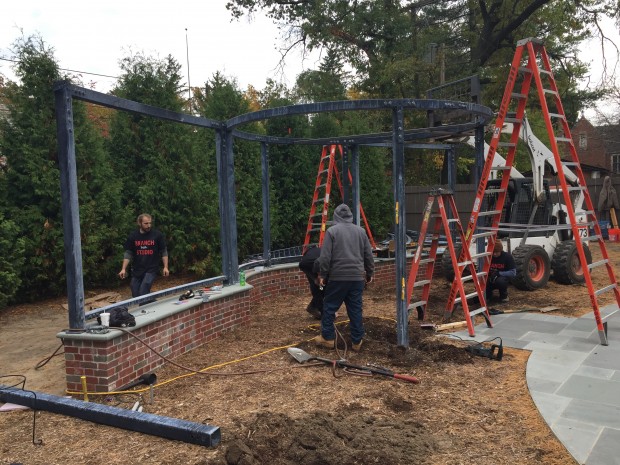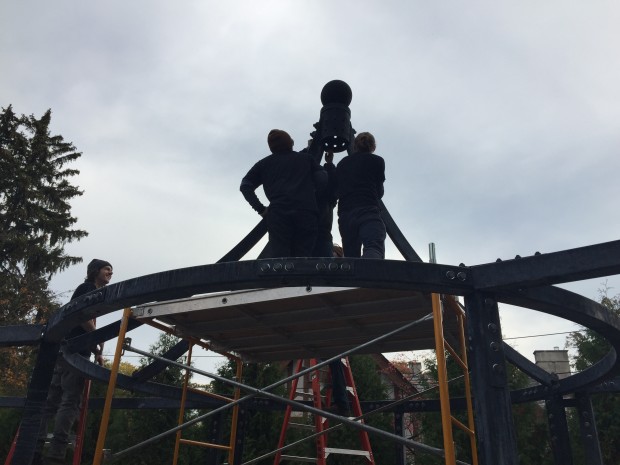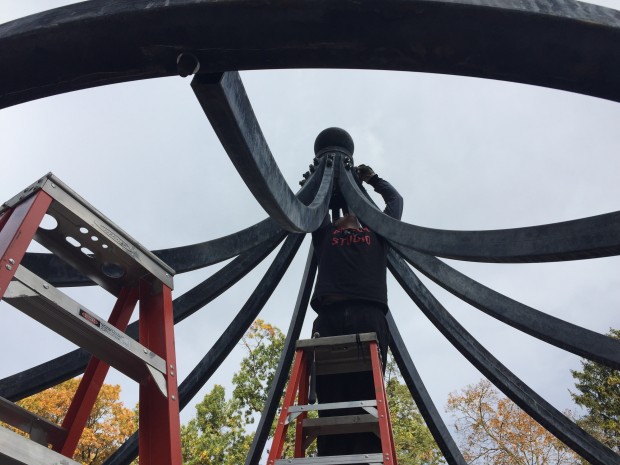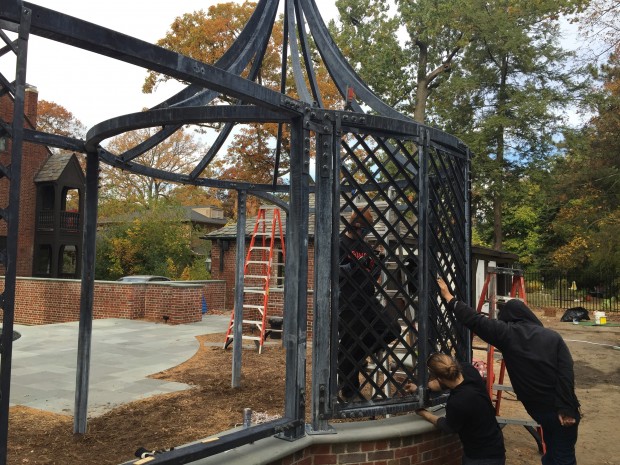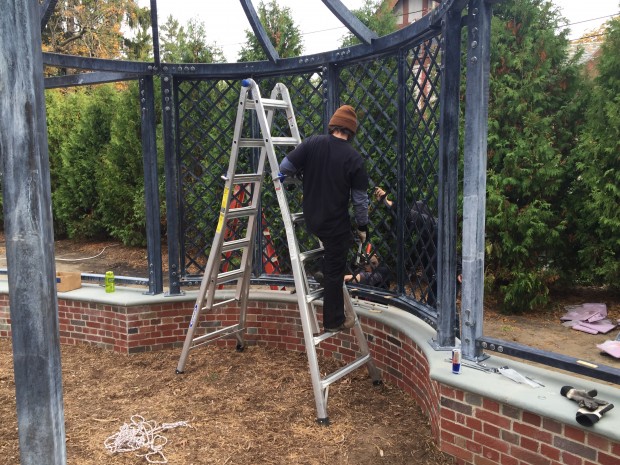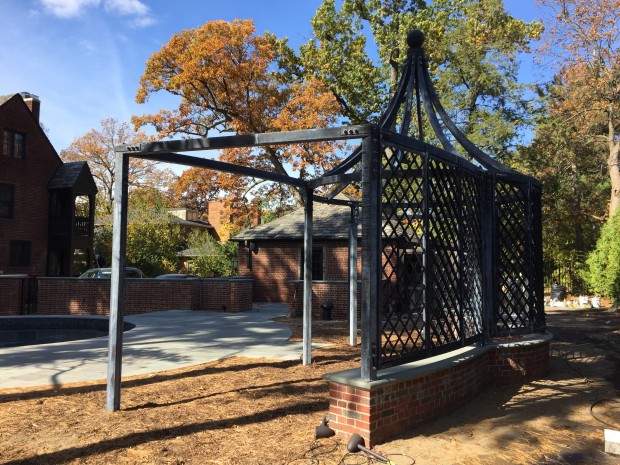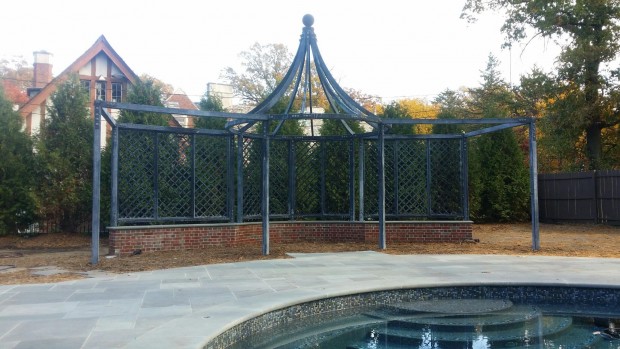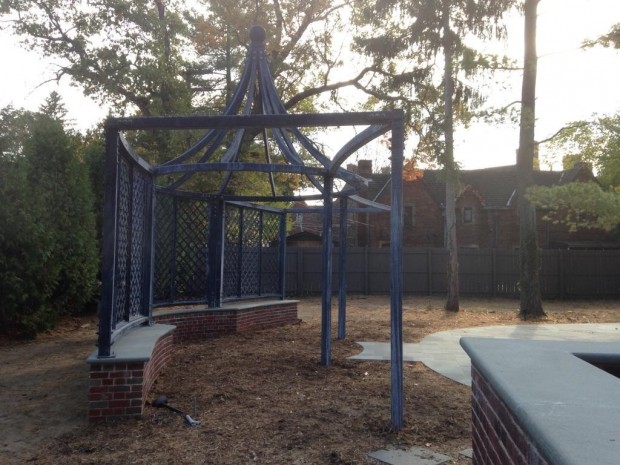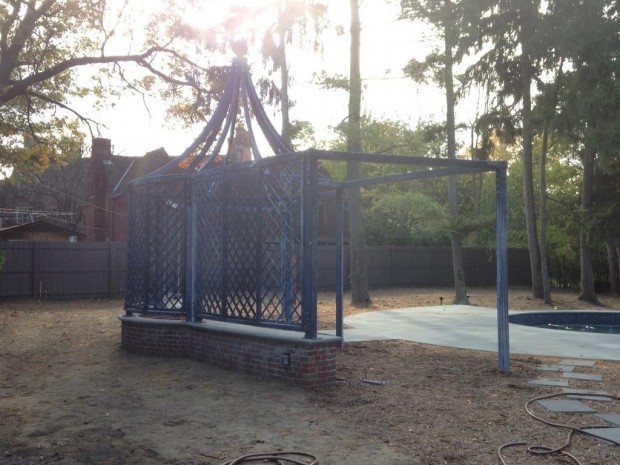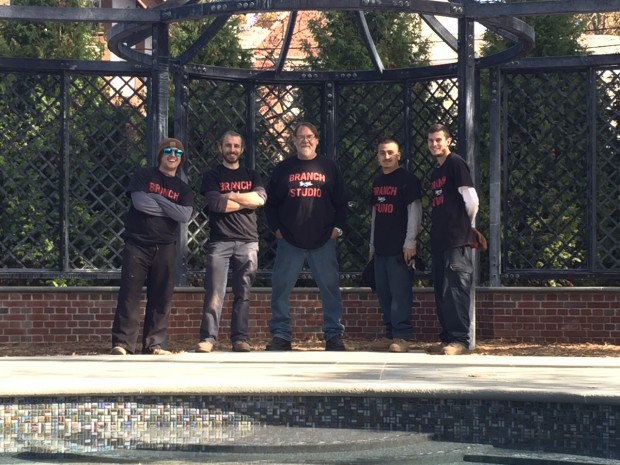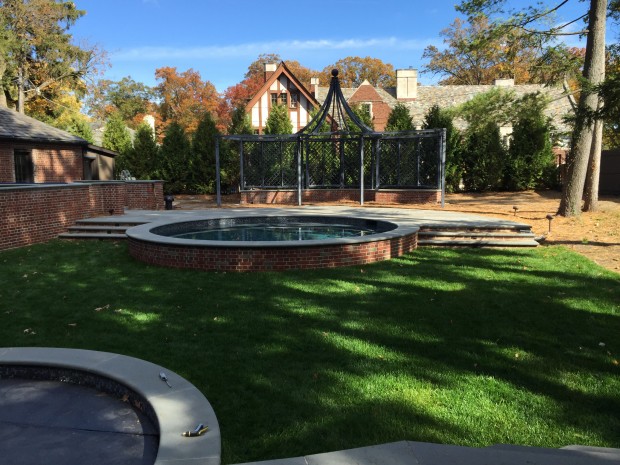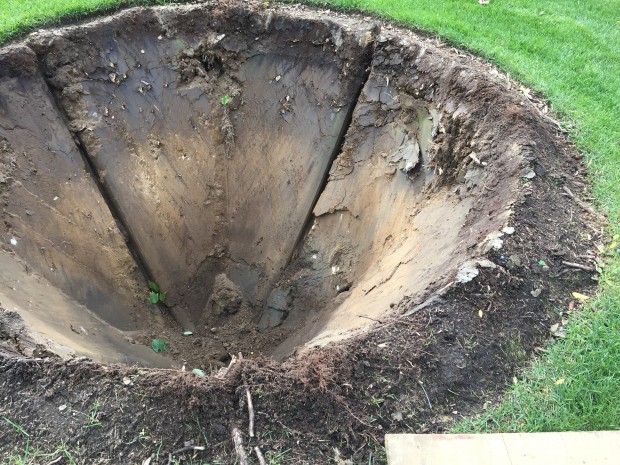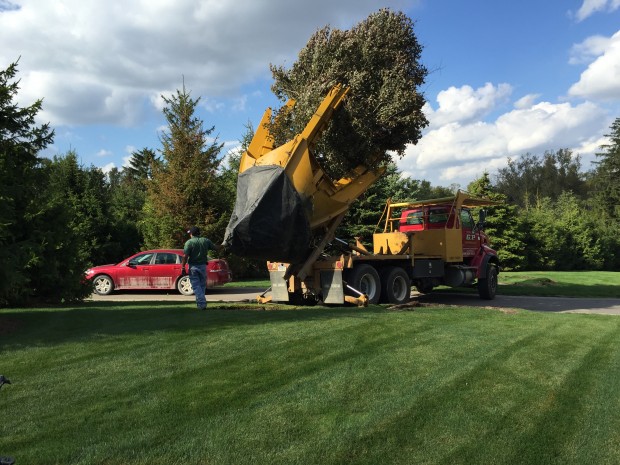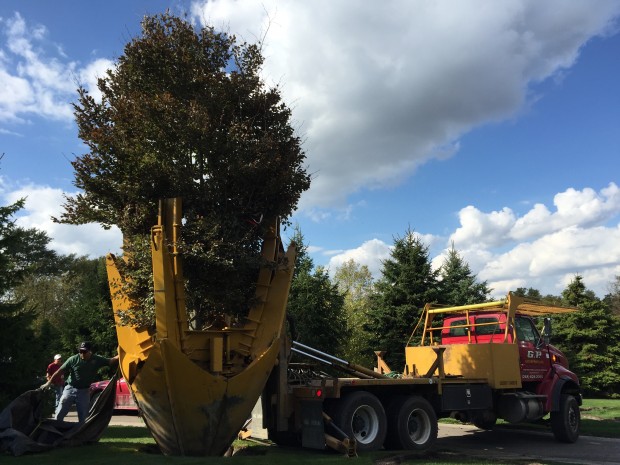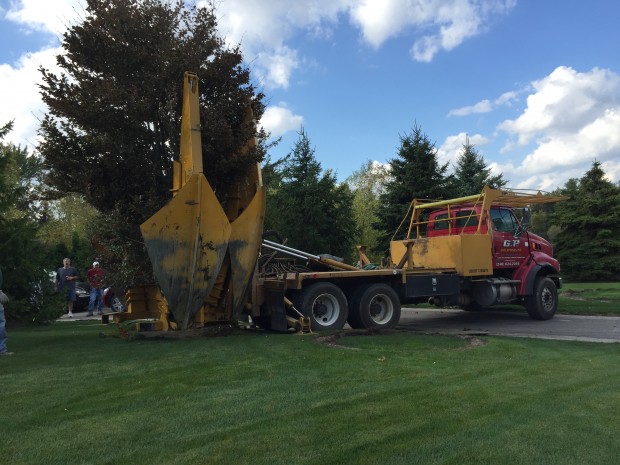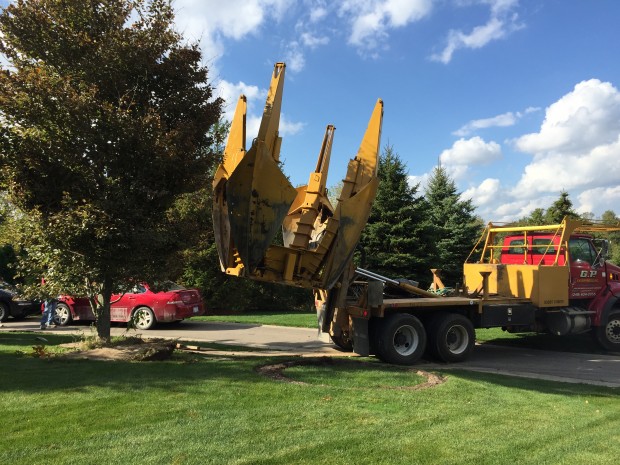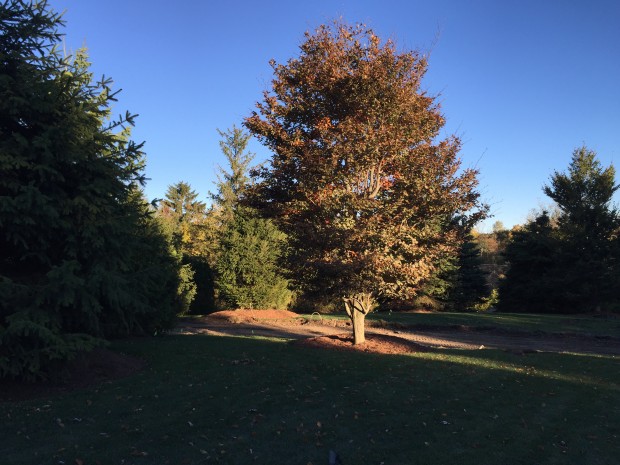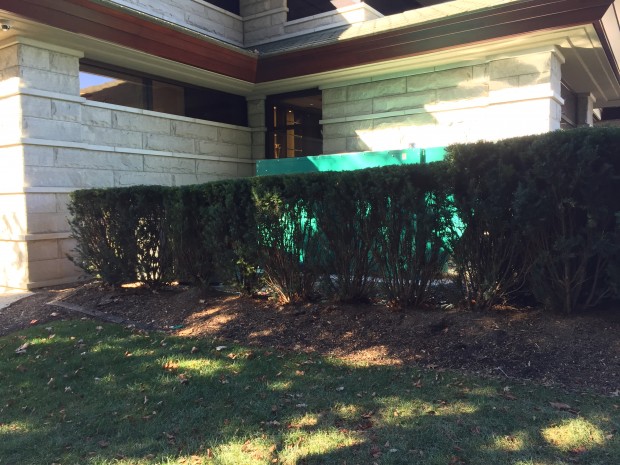 My last post about the 34 limber pines had to do with getting them off a truck, and transported some 450 feet up hill to the place where they would be planted. The first set of 14 Vanderwolfs would be planted around this generator. Building codes in this community specifies that a generator must be completely screened. These old existing yews were several feet too short, and too thin. It is a very large and tall generator. I ordinarily would not think to screen with trees, but in this case, I felt that Vanderwolf’s pines would do more than provide a screen. They would be a feature of the landscape.
My last post about the 34 limber pines had to do with getting them off a truck, and transported some 450 feet up hill to the place where they would be planted. The first set of 14 Vanderwolfs would be planted around this generator. Building codes in this community specifies that a generator must be completely screened. These old existing yews were several feet too short, and too thin. It is a very large and tall generator. I ordinarily would not think to screen with trees, but in this case, I felt that Vanderwolf’s pines would do more than provide a screen. They would be a feature of the landscape.
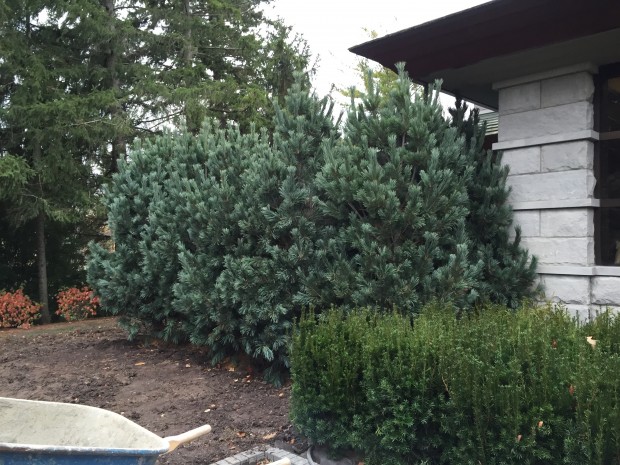 It is essential to preserve access to the generator for service. A flexibly stemmed soft needled pine is perfect for this function. A yearly pinching of the spring candles will keep these pines dense. Though shearing long needled pines is common in the landscape and Christmas tree industries, we will not shear these. We will take a branch or the new growth (called a candle) back to the main stem. We were easily able to co-mingle the branches from one tree to the next, as those branches are indeed very flexible. We set these columnar pines 4 feet apart. In the spring I will pinch out those wild hairs at the top, and lower the overall height about 18″. We will keep those trees below the overhang.
It is essential to preserve access to the generator for service. A flexibly stemmed soft needled pine is perfect for this function. A yearly pinching of the spring candles will keep these pines dense. Though shearing long needled pines is common in the landscape and Christmas tree industries, we will not shear these. We will take a branch or the new growth (called a candle) back to the main stem. We were easily able to co-mingle the branches from one tree to the next, as those branches are indeed very flexible. We set these columnar pines 4 feet apart. In the spring I will pinch out those wild hairs at the top, and lower the overall height about 18″. We will keep those trees below the overhang.
 That giant generator is no longer part of the landscape. Landscape designers regularly have to take the placement of outdoor structures in to account. Telephone poles, electrical lines, drain and manhole covers, generators, fire hydrants and transformers are all part of the urban landscape.
That giant generator is no longer part of the landscape. Landscape designers regularly have to take the placement of outdoor structures in to account. Telephone poles, electrical lines, drain and manhole covers, generators, fire hydrants and transformers are all part of the urban landscape.
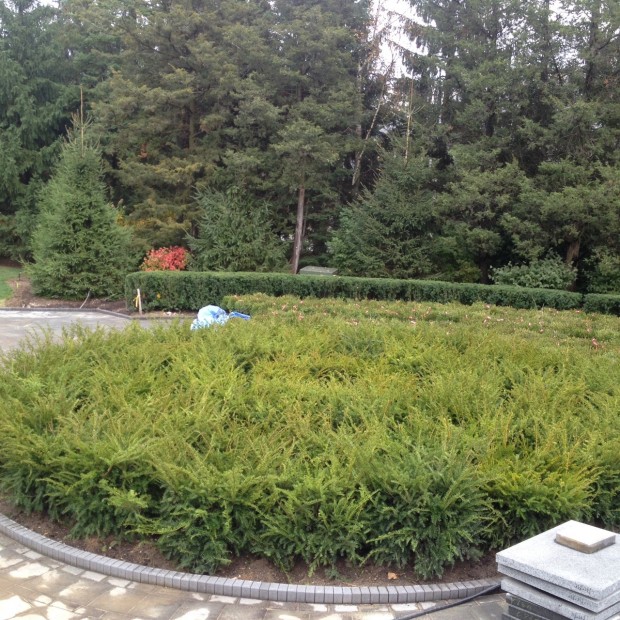 The landscape on this side of the circular driveway was a random mix of spruce, viburnum, and yews, backed up by the neighbor’s old junipers and spruce. It would not be long before the spruce would engulf the yews, and hang over the driveway. In the center island we had planted four circles of spreading cap yews. The outside ring is 36″ tall. The inside ring is 24″ tall. The mass will be kept loose, but in heights descending to the center. Perhaps some day they will add a sculpture there. Between the yews and the existing landscape is a group of Green Gem boxwood sitting on the driveway, which will be planted in front of the Joe Burke limber pines. And yes, there is a transformer there.
The landscape on this side of the circular driveway was a random mix of spruce, viburnum, and yews, backed up by the neighbor’s old junipers and spruce. It would not be long before the spruce would engulf the yews, and hang over the driveway. In the center island we had planted four circles of spreading cap yews. The outside ring is 36″ tall. The inside ring is 24″ tall. The mass will be kept loose, but in heights descending to the center. Perhaps some day they will add a sculpture there. Between the yews and the existing landscape is a group of Green Gem boxwood sitting on the driveway, which will be planted in front of the Joe Burke limber pines. And yes, there is a transformer there.
 Once the spruce and most of the viburnum were moved, it is easier to see the issues that would need addressing. The tall trunks are on the neighbor’s property. My clients driveway comes within 6 feet of the property line. I did consult with the neighbor and her landscape designer, and got permission to plant several of the dwarf pines a little over the property lines. I did explain that these trees would not impact her old trees like the spruce would have. Once we had her permission, there was still the issue of the transformer and cable box. The pines would be added on either side of the box. We would pick specific trees that seemed like they would handle that placement.
Once the spruce and most of the viburnum were moved, it is easier to see the issues that would need addressing. The tall trunks are on the neighbor’s property. My clients driveway comes within 6 feet of the property line. I did consult with the neighbor and her landscape designer, and got permission to plant several of the dwarf pines a little over the property lines. I did explain that these trees would not impact her old trees like the spruce would have. Once we had her permission, there was still the issue of the transformer and cable box. The pines would be added on either side of the box. We would pick specific trees that seemed like they would handle that placement.
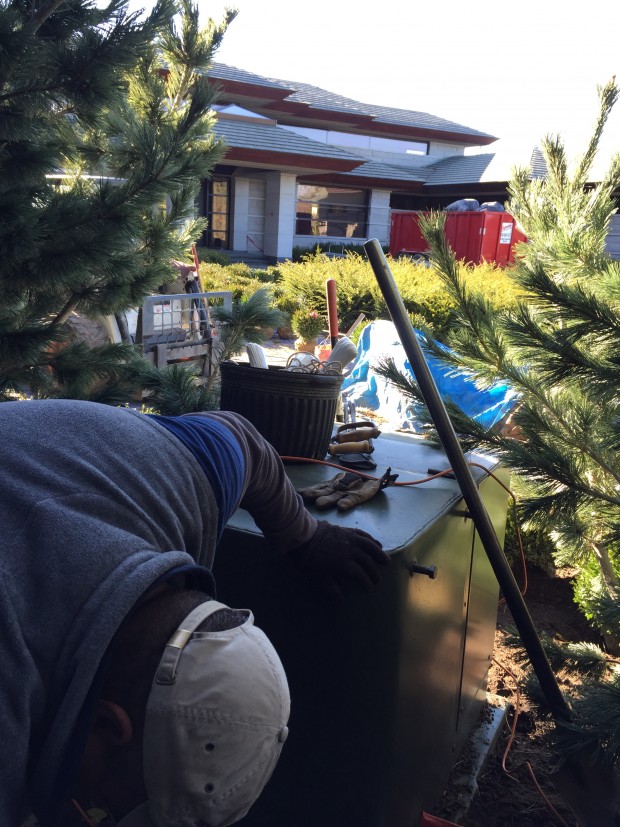 We were able to determine that a tree could be planted behind the box. We dug this hole very cautiously, and a number of lines, sprinkler and otherwise, traverse this area. Since we could not plant a tree in front of the transformer, behind would be the next best way to add that foliage and texture to that spot.
We were able to determine that a tree could be planted behind the box. We dug this hole very cautiously, and a number of lines, sprinkler and otherwise, traverse this area. Since we could not plant a tree in front of the transformer, behind would be the next best way to add that foliage and texture to that spot.
 Dan did the initial dig, and transplanted the viburnum. His was a fishing expedition. He did find sprinkler lines, which were rerouted out of the way of the root ball.
Dan did the initial dig, and transplanted the viburnum. His was a fishing expedition. He did find sprinkler lines, which were rerouted out of the way of the root ball.
 The curb of the new drive was protected by 4″ by 4″ timbers set on each side, and plywood over all. We needed our front end loader to set the trees, as the trees were much too heavy to lift. Once each tree was set in the trench that had been dug, they could be rotated in the hole for the best fit with the tree before. This area, where some of the juniper branches were low, each tree had to be carefully fit in to what was existing.
The curb of the new drive was protected by 4″ by 4″ timbers set on each side, and plywood over all. We needed our front end loader to set the trees, as the trees were much too heavy to lift. Once each tree was set in the trench that had been dug, they could be rotated in the hole for the best fit with the tree before. This area, where some of the juniper branches were low, each tree had to be carefully fit in to what was existing.
 Planting the tree behind the box came last.
Planting the tree behind the box came last.
 This tree had a slight crook in the trunk. When the ball was pitched forward, the branches came very close to the box. There is that perfect tree for every spot. That proximity was not a problem. The service would always be done on the front side.
This tree had a slight crook in the trunk. When the ball was pitched forward, the branches came very close to the box. There is that perfect tree for every spot. That proximity was not a problem. The service would always be done on the front side.
 These irregular growing pinus flexilis “Joe Burke” fit right in with the background landscape. As they grow, albeit slowly, they will meld in a friendly way to what is there.
These irregular growing pinus flexilis “Joe Burke” fit right in with the background landscape. As they grow, albeit slowly, they will meld in a friendly way to what is there.
 Once the trees were in, the wood, plywood, tarps and soil could be removed.
Once the trees were in, the wood, plywood, tarps and soil could be removed.
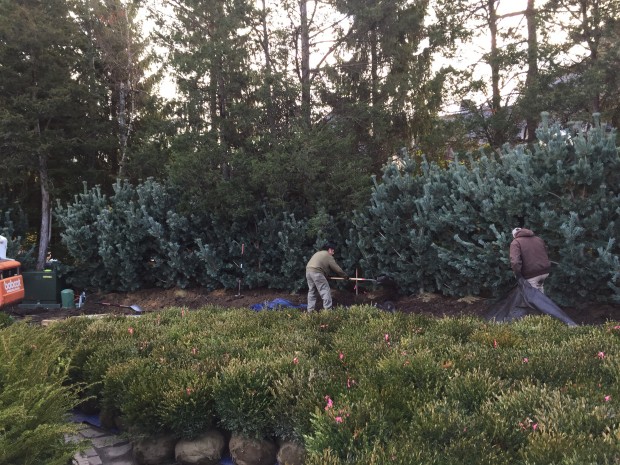 The last task was to back fill the trench with soil, and make sure the trees are straight. They will be getting a thorough soaking, which will help with the insult of being dug, moved, and replanted.
The last task was to back fill the trench with soil, and make sure the trees are straight. They will be getting a thorough soaking, which will help with the insult of being dug, moved, and replanted.
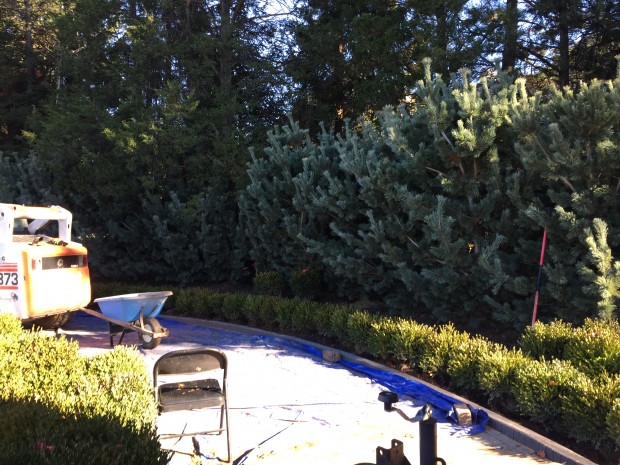 The trees will be faced down with Green Gem boxwood that is 15″ tall. Green Gem is very slow growing, and can be kept short. As the ground is rising here, the boxwood will have a slight bank.
The trees will be faced down with Green Gem boxwood that is 15″ tall. Green Gem is very slow growing, and can be kept short. As the ground is rising here, the boxwood will have a slight bank.
 Taller Green Mountain boxwood were used to screen the front of the generator. Once the flexible pines grow, there will be some melding going on here as well. Those big boxwood are not an especially graceful gesture , but they are a better look than that green box.
Taller Green Mountain boxwood were used to screen the front of the generator. Once the flexible pines grow, there will be some melding going on here as well. Those big boxwood are not an especially graceful gesture , but they are a better look than that green box.
